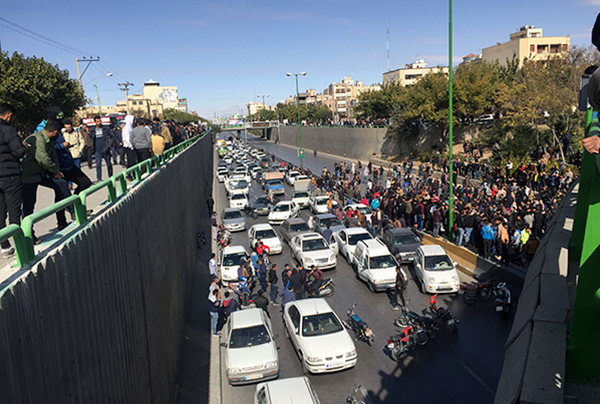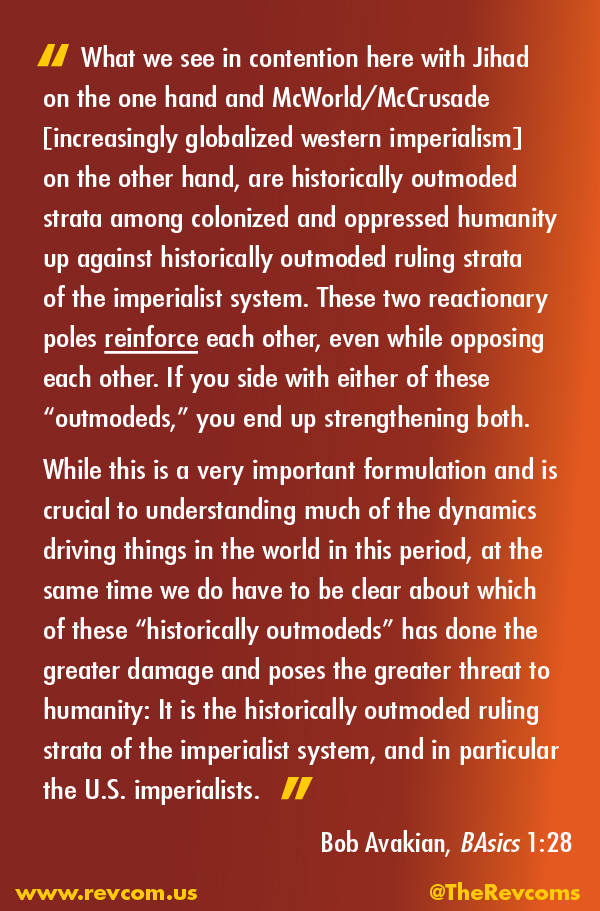Massive Protests Rock Iran:
Islamic Republic Shoots Down More Than 100, Injures or Arrests Thousands More
U.S. Sheds Crocodile Tears While Intensifying Collective Suffering, Risking War
| revcom.us
Massive protests have swept Iran. They began November 15, hours after the reactionary theocratic regime of the Islamic Republic of Iran (IRI) announced gas would be rationed and prices would rise sharply—with increases ranging from 50 percent up to 300 percent. These steep price increases immediately worsen the suffering of millions of Iranians who are already facing rampant inflation, high unemployment, and a harsh economic slowdown. (See the November 2019 statement from the Communist Party of Iran (Marxist Leninist Maoist) on these developments.)
The protests quickly spread across Iran to as many as 100 cities, large and small. In Tehran people used Waze, a navigation app, to organize “car protests”—parking on roads, creating road blocks and traffic jams.
The protests reportedly were largely peaceful, but Iran’s Supreme Leader Ayatollah Khamenei denounced protesters as “thugs” and “villains,” and the IRI responded violently—with water cannons, tear gas, and live ammunition fired from rooftops, helicopters, and police forces on the ground. At this writing, Amnesty International estimates that more than 140 Iranians have been killed—some shot at close range or while they were running away. Journalists inside Iran told the New York Times they believe that more than 200 have been killed, more than 1,900 wounded, and 7,000 arrested. There are reports that hospitals are overflowing with the wounded.
The IRI also shut down the internet in an attempt to halt the protests and prevent the world from witnessing its violent crackdown. It was reportedly the largest nationwide internet blackout ever to take place in Iran. Some journalists were also reportedly arrested.
A report by Amnesty International highlighted the viciousness of the IRI assault:
The frequency and persistence of lethal force used against peaceful protesters in these and previous mass protests, as well as the systematic impunity for security forces who kill protesters, raise serious fears that the intentional lethal use of firearms to crush protests has become a matter of state policy.... Several eyewitnesses have said that security forces have been taking away dead bodies and injured people from roads and hospitals. In a pattern consistent with past practices, intelligence and security forces have refused to return the bodies of many of the victims to their families or have forced families to bury their loved ones in a rushed manner and without an independent autopsy to establish the causes and circumstances surrounding the deaths. This is contrary to international law and standards on the investigation of unlawful killings.
These murderous assaults sparked justified outrage, as Iranians courageously continued, even stepped up, their resistance. Many denounced not only the price hikes but the whole suffocating, oppressive rule of Iran’s Islamic theocrats, and in regions like Kurdistan and Khuzestan against the national oppression the Kurdish and Arab people experience. In different places, protesters attacked, ransacked, and/or set fire to government offices, businesses, religious schools, state-run banks, and other symbols of the regime. Some chanted “Death to Khamenei.” Cities large and small reportedly looked like war zones.
The Trump/Pence Regime: Shedding Crocodile Tears, Escalating Collective Punishment
Trump and Secretary of State Mike Pompeo have publicly declared that they’re standing with the protesters and the “Great Iranian People,” as Trump claimed in a tweet, and they’ve condemned the IRI’s violence and internet shutdown.
In reality, it’s America’s unilateral pullout from the multinational Iran nuclear deal1 and re-imposition of draconian sanctions as a form of economic warfare—in conjunction with the IRI’s dependence on oil exports—that have strangled Iran’s economy, causing a sharp drop in Iran’s oil exports, and fueling 40-plus-percent inflation. This has resulted in tremendous hardship.
As described by journalist Jon Letman:2
U.S. sanctions have put a chokehold on Iran’s economy, isolating nearly every sector of society from the global financial system and hurting ordinary citizens in a range of ways. Everything from Iran’s industrial base and vital oil production, to food, medicine and international scientific partnerships and research is being affected. Universities can’t buy books, engineers can’t purchase software, consumers are cut off from global online services and hospitals are unable to get vital life-saving supplies.... The many Iranian people I have interviewed have described some of the worst sanction impacts as hurting children and patients suffering from cancer, asthma, cardiovascular disease and other ailments. Media and academic reports back up their stories. Even when medicines, supplies and equipment are available, they are increasingly unaffordable.
This is precisely what the U.S. sanctions were intended to do—create massive suffering, discontent, even death and potentially revolt among the people in order to weaken or even topple the IRI’s theocratic regime so that U.S. imperialism can tighten its hold on the Middle East.
As we wrote earlier on the U.S. withdrawal from the nuclear treaty and its imposition of crippling sanctions:
Controlling the Middle East, with its massive oil reserves and location at strategic and trade crossroads between Europe, Africa, and Asia, has been crucial to the power, dominance, and functioning of the U.S. empire for some 70 years. But over the past two decades, U.S. dominance has been shaken. Its wars in Iraq and Afghanistan failed to solidify America’s grip on the region and instead helped fuel more crisis, upheaval, and the spread of reactionary Islamic jihadism. In 2011, mass upheavals deposed pro-U.S. tyrants in Tunisia and Egypt, and led to a savage seven-year-long proxy war in Syria. Today, the U.S.-backed Saudi war has created the worst humanitarian crisis in the world in Yemen.
In the face of U.S. aggression, including its 2003 invasion of Iraq and support for Saudi Arabia, and these changes and upheavals, the oppressive, theocratic Islamic Republic of Iran (IRI), has been driven by its own perceived needs—and its ambitions—to expand its reactionary reach and influence in Iraq, Syria, Lebanon, Afghanistan, and now potentially Yemen. In the eyes of the U.S. rulers, Iran’s growing influence is the main regional threat to their stranglehold on the Middle East and to their barbaric allies, especially Israel and Saudi Arabia.
Now U.S. officials are reportedly bragging about how well their sanctions are working.
The Iranian government claims it has crushed the protests and arrested hundreds of the leaders, with some in the regime calling for the “maximum penalty”—in other words death—and the regime continues to greatly restrict internet use. These are not the actions of a regime confident of its power and its people, and the outrages and abuses by the IRI—and the U.S. imperialists—which drove the protests have not been resolved or gone away.
In that light, as we write in the editors’ note to the accompanying “Statement from the Communist Party of Iran (Marxist Leninist Maoist), November 2019”: “This struggle is in its main aspect overwhelmingly positive, and should be supported by revolutionary and progressive people. What makes this struggle stand out is that here there is an actual revolutionary communist party—the Communist Party of Iran (Marxist Leninist Maoist)—that is working to transform this into a revolutionary struggle. These efforts in particular should be strongly supported.”
Also, as we have noted before, the correct stance of revolutionaries in the U.S. toward the aggressive actions of its own government is one of “revolutionary defeatism.” In his book The New Communism, Bob Avakian notes that “Revolutionary defeatism means that you oppose the actions of your own government and ruling class in carrying out their wars, which are wars for empire.” (See the excerpts from the sections “Internationalism and an International Dimension” and “Internationalism—Revolutionary Defeatism.”)
1. For background, see previous revcom.us coverage including: “America—the Lying, Deal-Breaking Aggressor in the Persian Gulf” and “How Long Must This Go On? Tankers Damaged in Persian Gulf—America Again Ratchets Up Threats, Danger of War Against Iran.” [back]
2. “Intensified US Sanctions Bolster Iran’s Hardliners and Fuel Angry Protests,” truthout.org, November 19, 2019 [back]
A Region in Upheaval, Potential for War Looms
The upheaval in Iran is taking place as outbreaks of mass protest and rebellion erupt across the region, including protest directed against the oppressive Iranian-backed regime in Lebanon and against the U.S.- and Iranian-backed Iraqi regime. On Wednesday, November 27, protesters burned down Iran’s consulate in Najaf, Iraq, demanding “Iran Out.” More than 35 protesters were reportedly murdered by the Iraqi authorities.
Dangerous military threats and tensions also continue between the U.S. and its allies and Iran. Israel has provocatively attacked Iran-allied forces in Syria. Over the past months, the U.S. has deployed ships, high-tech weapons, and 14,000 more troops to the Middle East. Recently the U.S. commander there warned that Iran was under extreme pressure and may lash out. In response to the protests in Iran, a top general in Iran’s Revolutionary Guard blamed the U.S., Britain, Saudi Arabia, and Israel for stoking the unrest and ratcheted up threats of all-out military escalation.

When the reactionary theocratic regime of the Islamic Republic of Iran (IRI) announced gas would be rationed and prices would rise sharply, protests quickly spread across Iran to as many as 100 cities, large and small. In Tehran people used Waze, a navigation app, to organize “car protests”—parking on roads, creating road blocks and traffic jams. Photo: AP

Get a free email subscription to revcom.us:

